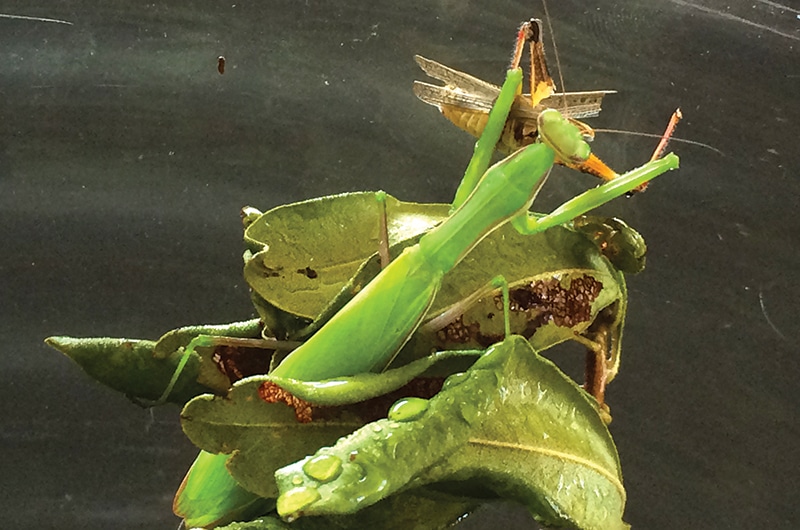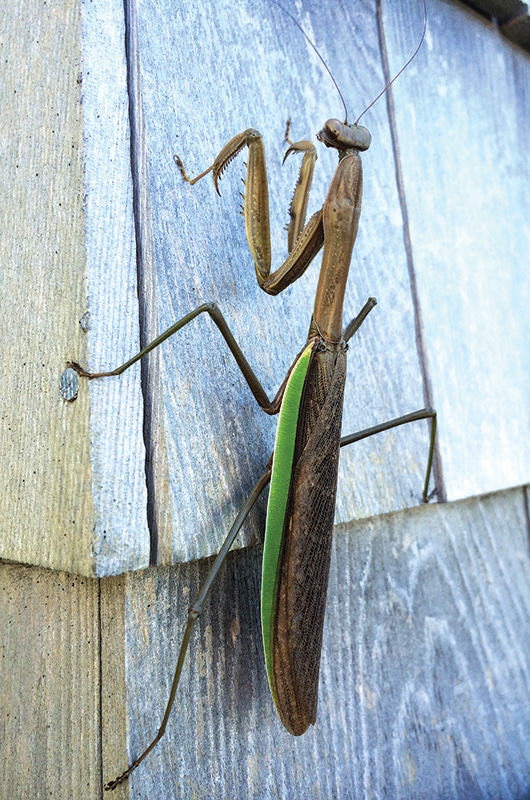by Dr. Sarah Treanor Bois
Director of Research & Education at the Linda Loring Nature Foundation
There’s an alien frolicking about Nantucket, hunting prey in our sandplain grasslands and heathlands. They’ve been known to tear the heads off of their prey and eat their mates for dinner. These ferocious beasts are mantids.
Mantids, of which the praying mantis is the best known, are an order of insects which consist of more than 2,400 species. As a group, they are found throughout the world in a variety of habitats. Even so, there are no native mantids to Nantucket or even Massachusetts.

The praying mantis is named for its prominent front legs, which are bent and held together at an angle mimicking a prayer pose. Those folded forelimbs are actually modified raptorial graspers equipped with specialized spikes for grabbing and holding onto prey. The mantis is a formidable predator, frequently preying on other insects, including grasshoppers, crickets, moths and flies. Their strong mouthparts allow them to tear apart the exoskeletons of their insect prey. Certain species, like the Chinese mantid (Tenodera sinensis), have even been known to impale and eat hummingbirds!
Mantids are able to turn their heads 180 degrees backwards and use their powerful eyes to scan for food. The praying mantis has only one ear, which is located on its belly in front of the hind legs. Mantids cannot detect the direction or frequency of sound, however they can detect ultrasound, which proves useful for evading their predators.
Female praying mantids are vicious, sometimes known to eat their mates. Occasionally, the female will even bite the head off of the male during copulation. Female mantises lay their eggs in the fall, attaching a batch of up to several hundred eggs to a plant stem or twig with a frothy liquid. This liquid hardens into a Styrofoam- like case that protects and insulates the eggs throughout the winter. Baby mantids, which resemble miniature adults, emerge in the spring.
Mantids are cannibalistic and will feed on their siblings after hatching if there is not enough space to move away from the hatch area. They spend the spring and summer eating and growing to maturity before mating in the fall. Depending on the species, most mantids live from six months to a year.
The heat of the summer tends to bring these incredible insects out as they are more visible in late August and September. Really, they hatched in early to mid-May when spring temperatures first arrived. Throughout the spring and early summer, they eat their way through Nantucket eventually reaching peak adult size between late August and September. It’s their size that suddenly makes them more visible this time of year.
In Charles Johnson’s 1930 publication A List of the Insect Fauna of Nantucket, Massachusetts, there were no mantids listed. Today, the island has two resident mantid species neither of which are native to Massachusetts or even North America. Both species were introduced into the Northeast in the 1890s to help control insect pests.
On the island, we now have two species of mantids that call Nantucket home. The European Praying Mantis (Mantis religiosa) is slender and bright green growing to about 3 inches long. These are the ones most people think of when we say “praying mantis.” The females are slightly larger and, while both sexes have wings, only the male can fly. The female makes up for it by being larger and more powerful.
The Chinese Mantis (Tenodera sinensis) is brown and larger than its European counterpart, growing up

to 5 inches long. This is the one that has been known to eat small birds. In 2015, the Nantucket Hotel found a Chinese mantis hanging out by the pool. Staff from the Linda Loring Nature Foundation were called in and captured the mantis before it started toasting its own marshmallows. That mantis was later brought to the Nantucket New School, where it was used in educational programming and lived out its remaining days eating crickets from the school’s basement.
While the mantids on Nantucket are not native, they are not considered invasive because they have not demonstrated ecological or economic harm on the island. In fact, many gardeners and farmers welcome the insects as they eat other insects which they consider pests.
To see any of our resident mantids, keep an eye out for movement along trail edges. While their coloration makes for great camouflage, their body size at this time of year makes them easier to spot when they’re in motion. After the fall, keep an eye out for any mantis egg cases which can be kept until hatching in spring. Just be sure to bring them out of doors well before hatching time or you may end up with some hungry nymph mantids on your windowsill.


